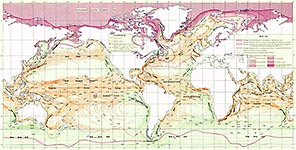Waves & Currents
039 Ocean currents -Corrientes Oceanicas
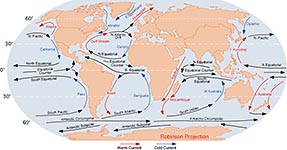 "An ocean current is a continuous, directed movement of seawater generated by forces acting upon this mean flow, such as breaking waves, wind, the Coriolis effect, cabbeling, temperature and salinity differences, while tides are caused by the gravitational pull of the Sun and Moon. Depth contours, shoreline configurations, and interactions with other currents influence a current's direction and strength.
"An ocean current is a continuous, directed movement of seawater generated by forces acting upon this mean flow, such as breaking waves, wind, the Coriolis effect, cabbeling, temperature and salinity differences, while tides are caused by the gravitational pull of the Sun and Moon. Depth contours, shoreline configurations, and interactions with other currents influence a current's direction and strength.Ocean currents flow for great distances, and together, create the global conveyor belt which plays a dominant role in determining the climate of many of the Earth´s regions. More specifically, ocean currents influence the temperature of the regions through which they travel. For example, warm currents traveling along more temperate coasts increase the temperature of the area by warming the sea breezes that blow over them. Perhaps the most striking example is the Gulf Stream, which makes northwest Europe much more temperate than any other region at the same latitude. Another example is Lima, Peru where the climate is cooler (sub-tropical) than the tropical latitudes in which the area is located, due to the effect of the Humboldt Current."
"Three main types of breaking waves:
- Spilling, or rolling. They can be found in most areas with, latively flat shorelines. They are the most common type of shorebreak
- Plunging, or dumping: these break suddenly and can "dump" swimmers -pushing them to the bottom with great force. These are the preferred waves for experienced surfers. Strong offshore winds and long wave periods can cause dumpers. They are often found where there is a sudden rise in the sea floor, such as a reef or sandbar.
- Surging: these may never actually break as they approach the water's edge, as the water below them is very deep. They tend to form on steep shorelines. These waves can knock swimmers over and drag them back into deeper water."
Wikipedia
©: PD Wikipedia
tags: #ocean currents #waves
,
040 Ocean waves -Katsushika Hokusai 'the Great Wave of Kanagawa'
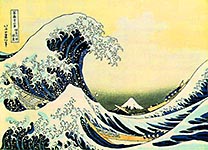 'The Great Wave off Kanagawa' (Kanagawa Oki Nami Ura, lit.'In the well of a wave off Kanagawa'), also known as 'The Great Wave' or simply 'The Wave', is a woodblock print (25.7 cm x 37.8 cm [10.1 in x 14.9 in]) by the Japanese ukiyo-e artist Hokusai. It was published sometime between 1830 and 1833 in the late Edo period as the first print in Hokusai's series 'Thirty-six Views of Mount Fuji' (Fugaku sanjurokkei). It is Hokusai's most famous work, and one of the best recognized works of Japanese art in the world. It depicts an enormous wave threatening boats off the coast of the prefecture of Kanagawa. As in all the prints in the series, it depicts the area around Mount Fuji under particular conditions, and the mountain itself appears in the background.
'The Great Wave off Kanagawa' (Kanagawa Oki Nami Ura, lit.'In the well of a wave off Kanagawa'), also known as 'The Great Wave' or simply 'The Wave', is a woodblock print (25.7 cm x 37.8 cm [10.1 in x 14.9 in]) by the Japanese ukiyo-e artist Hokusai. It was published sometime between 1830 and 1833 in the late Edo period as the first print in Hokusai's series 'Thirty-six Views of Mount Fuji' (Fugaku sanjurokkei). It is Hokusai's most famous work, and one of the best recognized works of Japanese art in the world. It depicts an enormous wave threatening boats off the coast of the prefecture of Kanagawa. As in all the prints in the series, it depicts the area around Mount Fuji under particular conditions, and the mountain itself appears in the background.Copies of the print are in many Western collections, including the Metropolitan Museum of Art in New York City, the British Museum in London, the Art Institute of Chicago, the National Gallery of Victoria in Melbourne, and in Claude Monet's house in Giverny, France, amongst many other collections.
©: PD en.wikipedia.org
tags: #Katsushika Hokusai #woodblock #Japan
,
040b Ocean waves -Gustave Courbet ´the Wave´
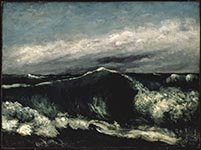 "Courbet was fascinated by the power of the sea. He spent the summer of 1869 at Etretat on the Normandy coast and painted several pictures of waves breaking on the shore. The small scale of his canvas did not inhibit his ability to convey the vast expanse of stormy sky and sea. Courbet applied paint thickly using vigorous brush and palette knife strokes which complement the forceful surge of the wave. The motif of the single wave was inspired by Japanese colour prints which were widely available in Paris in the 1860s."
"Courbet was fascinated by the power of the sea. He spent the summer of 1869 at Etretat on the Normandy coast and painted several pictures of waves breaking on the shore. The small scale of his canvas did not inhibit his ability to convey the vast expanse of stormy sky and sea. Courbet applied paint thickly using vigorous brush and palette knife strokes which complement the forceful surge of the wave. The motif of the single wave was inspired by Japanese colour prints which were widely available in Paris in the 1860s."©: text www.nationalgalleries.org
Gustave Courbet (French, 1819-1877). ´The Wave´ (´La Vague´), ca. 1869. Oil on canvas, 25 3/4 x 34 15/16 x 3in. (65.4 x 88.7 x 7.6cm). Brooklyn Museum
© painting: www.brooklynmuseum.org
tags: #wave #courbet #brooklyn museum #national galleries
ref. # 042e Energy -Wave & Tidal Stream Energy
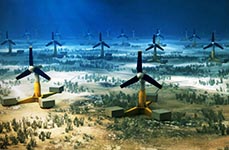 Wave & Tidal Stream Energy has the potential to supply 20 per cent of UK electricity avoiding 30 million tonnes of CO2 emissions each year.
Wave & Tidal Stream Energy has the potential to supply 20 per cent of UK electricity avoiding 30 million tonnes of CO2 emissions each year.Atlantis Resources' MeyGen Project in Scotland
With tidal stream technology turbines sit under the water and literally generate electricity as the tides move throught the turbine.
©: 30/6/2015 www.raconteur.net
tags: #Atlantis Meygen Tidal Energy Project
